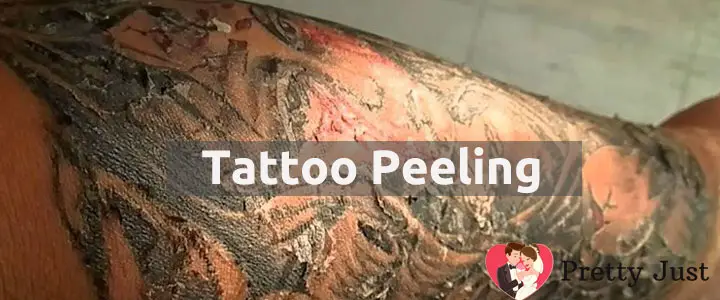Don’t freak out, tattoo peeling is normal. What should you do when your tattoo starts to peel?
Tattoo peeling is a natural part of the healing process, where the outer layers of skin shed to reveal the fresh tattoo underneath. It is often accompanied by dryness, itching, and sensitivity. Managing tattoo peeling involves regular moisturization, gentle cleansing, avoiding picking at the skin, and protecting the tattoo from sun exposure.
Seek medical advice if peeling is severe, shows signs of infection, or persists despite proper aftercare.
| Aspect | Description |
|---|---|
| Causes | – Natural Healing Process: Tattoo peeling is a normal part of the healing process as the outer layers of skin shed to reveal the fresh tattoo beneath. |
| – Dry Skin: Inadequate moisturization during the healing phase can exacerbate peeling, causing larger flakes of skin to come off. | |
| – Excessive Sun Exposure: Sunburn or prolonged exposure to UV rays can dry out the skin and accelerate peeling around the tattooed area. | |
| Symptoms | – Visible Peeling: The tattooed area may appear dry and flaky, with patches of skin sloughing off. |
| – Itching and Sensitivity: Peeling skin can be itchy and sensitive to touch, especially as new skin layers are exposed. | |
| Management | – Moisturization: Keep the tattooed area well-moisturized with a fragrance-free, hypoallergenic lotion or ointment to prevent excessive dryness. |
| – Gentle Cleansing: Clean the tattooed area with mild soap and water to remove dead skin cells and debris without causing irritation. | |
| – Avoid Picking: Refrain from picking or scratching at peeling skin, as this can disrupt healing and increase the risk of infection. | |
| – Sun Protection: Protect the tattoo from sun exposure by applying sunscreen with a high SPF, even after peeling has subsided. | |
| When to Seek Help | – Severe Symptoms: If peeling is excessive, accompanied by signs of infection (e.g., redness, swelling, pus), or persists beyond normal healing time, seek medical advice. |
| – Persistent Issues: If peeling continues to worsen or does not improve with proper aftercare, consult with your tattoo artist or a healthcare professional. |
Why Do Tattoos Peel?

To understand tattoo peeling, let’s take a close look at how the skin repairs itself from wound damage. Essentially, tattoos are wounds since the process required to break the skin in order to deposit ink into one of its lower layers. The uppermost skin layer gets quite damaged, you just don’t really notice it.
As a response, your skin will respond by working on repairing itself. This involves shedding dead skin cells so it can be replaced with newer and healthier ones.
The thing is, the skin does this on a regular basis. The body naturally exfoliates itself as a way of keeping the body healthy. We just don’t usually notice it because the dead skin you discard on a daily basis is very small in size. However, they’re the very reasons why you need to clean your mattress quite often, otherwise, up to 10 lbs of dead skin can accumulate in it over a 10-year period.
So if your tattoo starts to have a loose whitish film on top of it, don’t panic. It’s usually normal and it’s a sign that your body is working on healing the skin damage that the tattoo has inflicted on you.
On the flip side, you also don’t have to worry if your tattoo doesn’t peel. Different folks have different ways of skin healing, so you can be lucky if you don’t go through peeling. Do not try to induce it by scrubbing at the tattooed area, however, as that can cause some serious damage.
When to Worry
However, it’s also not impossible to have complications when your tattoo is peeling. In some cases, they can also be reasons for worrying. This is why you have to practice proper tattoo aftercare so you can aid your body in healing the tattooed area.
Generally, your tattoo will start peeling by the end of the first week of your tattoo healing process. It will typically peel for about two weeks, then it will make your new tat look more vibrant and defined. The healing process can still continue from that point but you’re already doing well if you’ve reached this period.
You should worry if you see other signs of inflammation, irritation, and scarring alongside your skin peeling. If your skin gets unbearably itchy, it could be a sign of an infection or allergic reaction from the ink, too. If you also see liquid discharge, it’s best to see a healthcare provider right away.
What To Do When Tattoo Peels
To help you effectively handle the tattoo peeling process, here’s a list of the things you should and shouldn’t do.
Do:
- Wear loose clothing if the tattoo is in a usually covered area. This will ensure that the fabric won’t rub on the healing wound.
- Continue to practice good aftercare practice so your skin will heal properly.
- Keep the tattooed area moisturized but not to a point that it’s always wet. Excess moisture will make it difficult for your skin to breathe and heal properly. It will also attract dirt and harmful microorganisms to the area.
Don’t:
- Force the dead skin to come off. Never pick, pull, scratch, or peel. Doing so can cause more damage to your skin. It can also cause scarring, more wounds, and infections.
- Soak the area for long periods. Keeping damaged skin wet will prevent it from healing quickly.
FAQs on Tattoo Peeling
To help you better understand the process of tattoo peeling and healing, here are some answers to the most commonly asked questions regarding the topic:
Do tattoos fade after they peel?
Tattoos shouldn’t fade after they peel because the ink is deposited in a lower layer of the skin known as the dermis. The skin layer that’s getting peeled is the epidermis which is the uppermost layer.
Because of this, there shouldn’t be a reason for the tattoo to fade after some skin peeling occurs. In fact, the tattoo should even look clearer and more vibrant because the skin layer above it is new and fresh.
If your tattoo looks faded after the peeling process, look for scarring or other hints of skin damage. If there’s none, get in touch with your tattoo artist so they can advise you with what steps to take next.
What Do You Do When Your Tattoo Is Peeling?
You don’t know what to do when tattoo peels? Keep these in mind when your tattoo is starting to peel:
- Do not scratch, pick, or peel on the loose fuzzy layer of skin to forcibly remove it. This will only damage your skin and maybe cause some infection and ruin your tattoo.
- Keep your tattoo clean and dry at all times as you should according to the proper aftercare measures.
- Keep the area moisturized. Doing so will help ease the sloughing off process of the dead skin.
Is It Normal For A Tattoo To Peel After 3 Days?
In some cases, tattoos can peel as early as 2 days. This really depends on how quickly your skin heals from damage. If it doesn’t look infected, then you don’t have to worry.
Do You Put Lotion On A Tattoo When It Peeling?
Keeping the tattoo moisturized is crucial to make the peeling process easier, more manageable, and less painful.
Why Is My Tattoo Still Peeling After 2 Weeks?
While some folks heal fast, others might heal more slowly. This can also be normal.
Conclusion
Tattoo peeling may be quite shocking but remember that it’s a normal part of the tattoo’s healing process. Handle it properly and you won’t have any issues with your tattoo.


